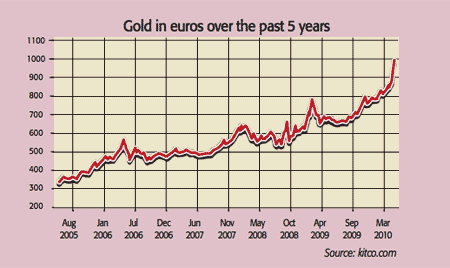
Germans “are buying krugerrands like crazy”, says Frank Ziegler of BayernLB. The Rand refinery in South Africa, which makes the popular gold coin, usually sells to banks about 2,000 at a time. But last week it received an order for 30,000, says Jack Farchy in the FT. Investors have also been flooding into US-based SPDR, the world’s biggest gold exchange-traded fund.
No wonder gold has jumped to a new record of around $1,250 an ounce. It has hit new peaks in euros and pounds too, eclipsing e1,000 and almost reaching £850 in sterling. Gold has risen even as the dollar has strengthened amid a general flight to safety, says David Rosenberg of Gluskin Sheff. The fact that it is gaining against major currencies shows that it is “increasingly being viewed as a currency of its own”. It is the ultimate safe haven and store of value. Turning on the printing presses can erode the value of paper money through inflation. But gold, being relatively rare, can’t be reproduced at the touch of a button.
Why Germany?
Since the eurozone rescue package allayed fears of a Lehman-style global meltdown, worries over currency debasement have taken centre stage. That’s especially the case in Germany, where Weimar-era hyperinflation remains “etched into the national psyche”, says Farchy. As part of the rescue operation the European Central Bank has begun to buy eurozone government bonds in order to stabilise the markets. This is not a bond-buying programme with printed money; the European Central Bank (ECB) plans to withdraw the money it spends on bonds from the system.
But Germans aren’t convinced that stance will last. Neither is Jim Reid of Deutsche Bank, who reckons the ECB will have to become “as aggressive” as the Fed or Bank of England to bring periphery member yields down. And as Ian Campbell points out on Breakingviews, the ECB has already offered unlimited funds to banks, as it did during the worst of the credit crunch.
It’s not just all this liquidity currently in the system that is making German investors nervous. Europe has always been split between two groups of countries, notes Joachim Starbatty on Wiwo.de. Some, notably Germany, value a strong currency and price stability. Others have tended to pile on debt, lose their competitiveness and then “solve” the problem by devaluing their currency and allowing inflation to take hold.
What Germans fear is that this mess is turning the eurozone into a member of the second group, making the euro a “drachma in disguise,” rather than a “deutschmark in disguise”, as HSBC’s David Bloom puts it. The ECB’s independence has also been undermined after its U-turn on buying bonds; Germany is having to cough up billions for the periphery; and there is widespread scepticism over whether these countries can cope with its austerity packages. The fear of the eurozone ultimately breaking up as southern countries default is also undermining the euro and spurring demand for a safe haven.
Gold’s run has further to go
“There is simply more global debt than can be comfortably serviced,” says Tim Price of PFP Wealth Management. And official public-debt-to-GDP figures omit liabilities such as pension and health benefits, for which no money has been set aside. Factor these in and Britain’s debt pile, for instance, rockets to more than 300% of GDP. “The temptation to inflate away” debt will become “irresistible,” says Morgan Stanley.
Meanwhile, gold production peaked a decade ago, central banks are buying gold again, and Chinese demand is expected to double over the next decade. What’s more, the gold market is small and thinly traded – long-term bull markets usually end in “parabolic blow-offs”, notes Rosenberg. So it’s easy to see the yellow metal spiking much higher over the next few years.